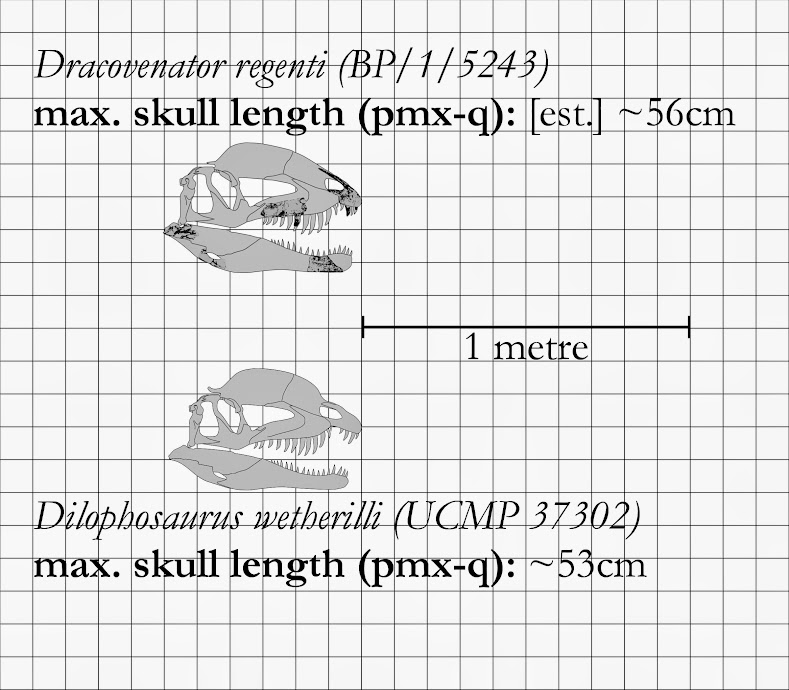Post by theropod on May 9, 2015 17:07:42 GMT 5
Dracovenator regenti is a species of coelophysoid theropod from the lower Jurassic of South Africa.
 →
→
Comparison between the holotypes of Dracovenator and Dilophosaurus see also here→ and here→ for more details.
Material:
Holotype, BP/1/243: partial premaxillae, fragments of right maxilla, angular, dentary and articular region of mandible. Skull estimated at 50cm-56cm (see diagram above and Yates 2005).
possible paratype: BP/1/5278, partial juvenile rostrum (Yates 2005)
Locality and Horizon:
Upper Elliot Formation: Hettangian-Sinemurian (PaleoDB)
Anatomy & Palaeobiology:
As the largest theropod of its ecosystem, supposedly an apex predator. Probable primary prey small- to mid-sized dinosaurs (stem-sauropodomorphs and ornitischians, smaller theropods).
Most Premaxillary teeth are ziphodont, atypical for Coelophysoidea, premaxillary diastema and crest are less pronounced and posterior maxillary teeth appear to be more closely spaced than in Dilophosaurus, articular end of mandible is shallower relative to dentary (cf. Yates 2005, Welles 1984, Tykoski & Rowe 2004). Otherwise supposedly similar to other large coelophysoids (e.g. Dilophosaurus).

Phylogeny:
Basal neotheropod.
Dracovenator might form a clade with Dilophosaurus and Zupaysaurus, either a member of a monophyletic Coelophysoidea or the sister taxon of the tetanurae+Neoceratosauria-node (Yates 2005). Consensus has not been reached as to whether a monophyletic coelophysoidea is recognized (e.g. Martinez et al. 2011) or not (e.g. Sues et al. 2011), but most works published since its description (except for Smith et al. 2007) have not included Dracovenator.
–––References:
Martínez, Ricardo N.; Sereno, Paul C.; Alcober, Oscar A.; Colombi, Carina E.; Renne, Paul R.; Montañez, Isabel P.; Currie, Brian S. (2011): A Basal Dinosaur from the Dawn of the Dinosaur Era in Southwestern Pangaea. Science, Vol. 331 (6014) pp. 206-110
PaleoDB: Fossilworks, Gateway to the Paleobiology Database. Upper Elliot Formation. fossilworks.org/bridge.pl?action=displayStrata&geological_group=Stormberg&formation=Upper%20Elliot&group_formation_member=Upper%20Elliot (accessed 09 May 2015)
Smith, Nathan D., Makovicky, Peter J.; Pol, Diego; Hammer, William R.; Currie, Philip J. (2007): The Dinosaurs of the Early Jurassic Hanson Formation of the Central Transantarctic Mountains: Phylogenetic Review and Synthesis. In: Cooper, Allen; Raymond, Carol; ISAES Editorial Team: Antarctica: A Keystone in a Changing World–Online Proceedings for the 10th International Symposium on Antarctic Earth Sciences. Santa Barbara (Short Research Paper 3) pp. 1-5
Sues, Hans-Dieter; Nesbitt, Sterling J.; Berman, David S.; Henrici, Amy C. (2011): A late-surviving basal theropod dinosaur from the latest Triassic of North America. Proceedings of the Royal Society B, Vol. 278 (1723) pp. 3459-3464
Tykoski, Ronald S.; Rowe, Timothy (2004): Ceratosauria. In: Weishampel, David B.; Dodson, Peter; Osmólska, Halszka: The Dinosauria. Berkeley pp. 47-70
Welles, Samuel P. (1984): Dilophosaurus wetherilli (Dinosauria, Theropoda) Osteology and Comparisons. Palaeontographica Abt. A, Vol. 185 pp. 85-180
Yates, Adam M. (2005): A new theropod dinosaur from the Early Jurassic of South Africa and its implications for the early evolution of theropods. Palaeontologia Africana, Vol. 41 pp. 105-122
 →
→Comparison between the holotypes of Dracovenator and Dilophosaurus see also here→ and here→ for more details.
Material:
Holotype, BP/1/243: partial premaxillae, fragments of right maxilla, angular, dentary and articular region of mandible. Skull estimated at 50cm-56cm (see diagram above and Yates 2005).
possible paratype: BP/1/5278, partial juvenile rostrum (Yates 2005)
Locality and Horizon:
Upper Elliot Formation: Hettangian-Sinemurian (PaleoDB)
Anatomy & Palaeobiology:
As the largest theropod of its ecosystem, supposedly an apex predator. Probable primary prey small- to mid-sized dinosaurs (stem-sauropodomorphs and ornitischians, smaller theropods).
Most Premaxillary teeth are ziphodont, atypical for Coelophysoidea, premaxillary diastema and crest are less pronounced and posterior maxillary teeth appear to be more closely spaced than in Dilophosaurus, articular end of mandible is shallower relative to dentary (cf. Yates 2005, Welles 1984, Tykoski & Rowe 2004). Otherwise supposedly similar to other large coelophysoids (e.g. Dilophosaurus).

Phylogeny:
Basal neotheropod.
Dracovenator might form a clade with Dilophosaurus and Zupaysaurus, either a member of a monophyletic Coelophysoidea or the sister taxon of the tetanurae+Neoceratosauria-node (Yates 2005). Consensus has not been reached as to whether a monophyletic coelophysoidea is recognized (e.g. Martinez et al. 2011) or not (e.g. Sues et al. 2011), but most works published since its description (except for Smith et al. 2007) have not included Dracovenator.
–––References:
Martínez, Ricardo N.; Sereno, Paul C.; Alcober, Oscar A.; Colombi, Carina E.; Renne, Paul R.; Montañez, Isabel P.; Currie, Brian S. (2011): A Basal Dinosaur from the Dawn of the Dinosaur Era in Southwestern Pangaea. Science, Vol. 331 (6014) pp. 206-110
PaleoDB: Fossilworks, Gateway to the Paleobiology Database. Upper Elliot Formation. fossilworks.org/bridge.pl?action=displayStrata&geological_group=Stormberg&formation=Upper%20Elliot&group_formation_member=Upper%20Elliot (accessed 09 May 2015)
Smith, Nathan D., Makovicky, Peter J.; Pol, Diego; Hammer, William R.; Currie, Philip J. (2007): The Dinosaurs of the Early Jurassic Hanson Formation of the Central Transantarctic Mountains: Phylogenetic Review and Synthesis. In: Cooper, Allen; Raymond, Carol; ISAES Editorial Team: Antarctica: A Keystone in a Changing World–Online Proceedings for the 10th International Symposium on Antarctic Earth Sciences. Santa Barbara (Short Research Paper 3) pp. 1-5
Sues, Hans-Dieter; Nesbitt, Sterling J.; Berman, David S.; Henrici, Amy C. (2011): A late-surviving basal theropod dinosaur from the latest Triassic of North America. Proceedings of the Royal Society B, Vol. 278 (1723) pp. 3459-3464
Tykoski, Ronald S.; Rowe, Timothy (2004): Ceratosauria. In: Weishampel, David B.; Dodson, Peter; Osmólska, Halszka: The Dinosauria. Berkeley pp. 47-70
Welles, Samuel P. (1984): Dilophosaurus wetherilli (Dinosauria, Theropoda) Osteology and Comparisons. Palaeontographica Abt. A, Vol. 185 pp. 85-180
Yates, Adam M. (2005): A new theropod dinosaur from the Early Jurassic of South Africa and its implications for the early evolution of theropods. Palaeontologia Africana, Vol. 41 pp. 105-122

